| This page includes stories, anecdotes and photos from HMAS MILDURA's war years. This includes minesweeping, anti submarine patrols, convoy escort, and the capture of the Hong Kong brewery. Story List:
The MILDURA was involved in protecting convoys from attack by Japanese submarines. The height of the conflict was along the East Coast during 1942-43. Japanese subs sank 18 ships, damaged another 15, and over 600 lives were lost. Little of this battle on Australia's door step was reported at the time, and it is still relatively unknown (despite having more casualties than Australia's Vietnam losses). There was never much shore leave during this period as there just weren't enough warships to escort the convoys. Most of the time it was just hard gruelling sea time, with the weather mostly foul. The submarines attacking the convoys were monsters, the I-21 displaced 1950 tons and with a speed of 24 knots. (MILDURA weighed 680 tons and a speed of 15 knots.) The submarines also were more powerfully armed than the corvettes with 5.5 inch gun, triple .5 inch machine guns and eight 21 inch torpedo tubes. The I-21 carried a crew of 94, 17 torpedos and could remain at sea for 90 days with a range of 16,000 nautical miles. On June 7 & 8, 1942, the I-21 shelled the city of Newcastle, the shipyards and the steelworks. The damage would have been extensive, but most of the shells failed to explode. The sub carried a float plane which was used to check out shipping in Melbourne and Sydney prior to the raids by the midget submarines. It was the I-21 that damaged the liberty ship, Peter H. Burnett, which the MILDURA successfully towed back to Sydney, and the MILDURA pursued the I-21 after it torpedoed the Iron Knight off Narooma in February 1943. The I-21 was eventually sunk on 4th February 1944 by US destroyer USS Charrette near the Marshall Islands. 
June 1943 the MILDURA was delayed by fog off Gellibrand light and the escorts spent the night off Portsea and eventually got going north in very foul weather on 15th June. On June 21, the convoy was off Lakes Entrance, with an Avro Anson providing air cover. The plane was W2261 of 67 Squadron, Laverton. The squadron used airstrips at Yanakie and Mallacoota to patrol Bass Strait. The crew was P/O A. Packer 410371, F/Sgt. Cooper 408202 and Sgt. B.F. Duffy. The Avro plunged into the sea quite close to MILDURA who raced to the rescue. Pilot Officer A. Packer and Sgt. Duffy were rescued, but F/Sgt. Cooper did not survive the impact. 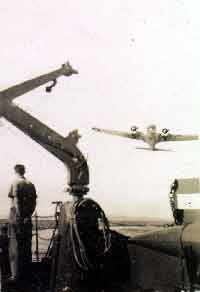
Medical attention was provided by SBA Rob
"Doc" Hill and A/S Subbie, Charlie Prescott, then part way through a veterinary science course at Sydney University. Meanwhile the MILDURA proceeded at top speed and handed over the airmen to an RAAF crash boat at Queenscliff. A signal received later from RAAF authorities congratulated the MILDURA's "doctors" on excellent results achieved. After landing the injured airmen MILDURA raced back to the convoy and eventually made Newcastle on June 25. F/Sgt
Duffy was killed in Avro Anson W2039 on the 4th Oct 1943. The Anson
stalled in a turn and crashed into water at Gipsy Point near Mallacoota
Victoria 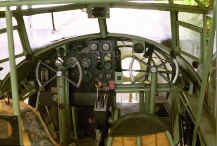 | Two photos of an Avro Anson currently being restored in Ballarat. Pictures courtesy of
Rick Hanning
| 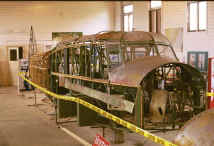 | 
At the end of the war, MILDURA was assigned to work with the British
Pacific Fleet. As the senior ship of the minesweeping group, MILDURA led the sweep along the sea lane approach to Hong Kong. The MILDURA was the first allied warship to re-enter the harbour, ahead of the British battleship HMS
ANSON, the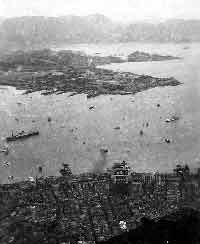 carriers HMS
INDOMITABLE and HMS VENERABLE, the cruisers HMS SWIFTSURE and HMS
EURALUS, depot ship HMS MAIDSTONE, four destroyers, submarines and RAN
corvettes HMAS's CASTLEMAINE, STAWELL, BATHURST, BROOME, FREMANTLE,
STRAHAN and WAGGA. carriers HMS
INDOMITABLE and HMS VENERABLE, the cruisers HMS SWIFTSURE and HMS
EURALUS, depot ship HMS MAIDSTONE, four destroyers, submarines and RAN
corvettes HMAS's CASTLEMAINE, STAWELL, BATHURST, BROOME, FREMANTLE,
STRAHAN and WAGGA. On approach to Tathong Point frantic signals were made by the Japanese to keep out because the channel was dangerous. The shore batteries had their huge
18 inch guns trained on the ship. Allan Waugh, signalman, reading the signals from the Japanese found this was the scariest moment of his life.
The Japanese signalled "Stop immediately." The Japanese
signalled the command ship HMS MAIDSTONE, "Send rescue ship for
your leading ship's crew. They have gone too far." However, we continued and received orders to turn and sweep out only when well inside. Several
days later the 8 corvettes were joined by HMAS's BALLARAT, BENDIGO,
WHYALLA, MARYBOROUGH, BURNIE, CESSNOCK, GERALDTON, GAWLER, WOLLONGONG,
TAMWORTH, PIRIE, LAUNCESTON, GOULBURN and TOOWOOMBA and the dangerous
task of minesweeping began in earnest. 
In the days that followed entering Hong Kong, the MILDURA sailed down the coast to capture
the San Miguel brewery. A full platoon of Royal Marines in full combat
gear were embarked. The twenty Japanese soldiers occupying the
brewery surrendered their weapons and were made to squat on the
MILDURA's quarter deck. The marines returned to the brewery to mop up.
Two hours later there was a commotion at the top of the hill and a
flat top rail trolley came thundering down with a cargo of cartons of
beer and some very happy marines. Petty Officer Ernie Morrison said "It
was very clear they had been very successful in mopping up what
they had found in the 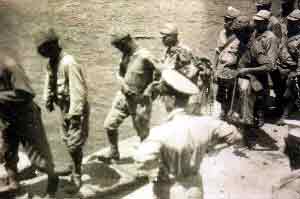 brewery
and were as loaded as their overloaded trolley. It was also clear that
they either did not know or did not care that the rail track took a vicious
turn halfway down the jetty. The trolley failed to negotiate the bend,
left the track and catapulted the marines and the beer into the
sea." The MILDURA was loaded with crates of beer, looking like a modern container ship. The beer turned out to be
"almost undrinkable", a great disappointment to all the crew. brewery
and were as loaded as their overloaded trolley. It was also clear that
they either did not know or did not care that the rail track took a vicious
turn halfway down the jetty. The trolley failed to negotiate the bend,
left the track and catapulted the marines and the beer into the
sea." The MILDURA was loaded with crates of beer, looking like a modern container ship. The beer turned out to be
"almost undrinkable", a great disappointment to all the crew. The late “Fanny” Medwin commented a few years ago, “You know, I kept a bottle of that stuff and recently opened it – it hadn’t improved with age!” This is the text of the message sent to the Naval Officer in Charge, Sydney, May 13, 1943, from the Commanding Officer of HMAS MILDURA, Claude Guille, Lieutenant RNR. The location is Bass Strait.

Torpedo Attack on Convoy O.C.93. Position: at 2334K 12th May 1943 36° 33’S, 150° 35’E Course: 009°, 9.5 knots Weather: Clear, fine, sea calm and very phosphorescent. Wind 0 to 1, visibility 8, convoy visible at 3 miles. Station: As ordered, abeam of last ship of starboard column, 3000 yards, zig-zagging. A/S sweep 60° on port bow, 100° on starboard bow. At 2334K/12 in above circumstances, HMAS MILDURA struck a submerged object. The blow was slight, but distinct and felt by me in the Commanding Officer’s cabin. The Engineer Officer also felt it in his cabin aft. I immediately went to the bridge, arriving not more than 20 seconds after the ship had made contact. No one on the bridge had seen or felt anything. The immediate vicinity of the ship was scanned for signs of broken water etc which would have been clearly visible had anything broken the surface or had the object been a submarine in the act of submerging. A/S range was 4000 yards at this time and the A/S operator, who is an alert rating has heard nothing. He felt the bump, but did not hear it in the A/S set. At 2337, while still scanning the immediate vicinity of the ship from the starboard wing of the bridge, I saw a white track emerge from under the ship abreast the funnel on the starboard side and disappear on the starboard beam. The starboard lookout also saw it, but the port did not. The track was about 18 inches wide, quite straight and appeared to be travelling at about 20 knots. It also appeared to be slowing down as it disappeared, but this may have been just an optical illusion. The alarm from Mersigs, i.e., rockets and syren (sic), was given at once and course altered and “MILDURA” ran down at full speed along the track in the direction in which it was estimated that the torpedo had come. At the same time, S.O.E. (HMAS WARRNAMBOOL) was informed by light and HMAS DELORAINE by R/T. Communication was maintained with DELORAINE throughout but S.O.E’s R/T was not apparently working at any time in the passage from Sydney to the time of this happening. In arrival on the quarter of the convoy, course was altered to 150° and a large patch of phosphorescence investigated. No echoes were obtained at any time nor was hydrophonic effect heard, though sweeps were made for this. Nevertheless a depth charge, set 100 ft was dropped in the phosphorescent patch, and this bringing no effect, course was resumed. At 0021K/13 HMAS MILDURA was ordered by S.O.E. to take up station “G” and HMAS DELORAINE to continue to search. Station was thereupon regained. At the same time it is observed that the A/S operator who had been warned against H/E of torpedoes and is a keen rating, was investigating the port side for hydophone effect at the time the track was seen and he states he heard nothing. In this connection it is also pointed out that when the S.S. IRON KNIGHT was lost, the A/B operator in HMAS TOWNSVILLE stated that the hydrophone effect of the torpedo was so slight that he thought it not worthy of reporting. Another possible factor is that MILDURA is fitted with an oscillator of “F” frequency, which I understand does not pick up hydrophone effect as well as the lower frequencies. A number of phosphorescent patches had been observed earlier in the watch, and it is now considered that the one attacked was no more than its appearance suggested – a plain phosphorescent patch of water. A signal has been made asking for a diver to look at the ship’s underwater plating for a clue to the object which the ship struck at 2334K/12. Diagram of movements is attached.
The Navy’s official reply commented that the MILDURA should also have dropped an occasional depth charge along the assumed torpedo track. The report also stated “…From the evidence, it now appears that the phosphorescent track sighted was caused by fish and not by torpedo.” C.O. Guille was less than impressed that the Navy thought he couldn’t tell the difference between a torpedo and a fish! Japanese submarines I-26, I-177, I-178, I-174 and I-180 were operating off the east coast at this time. The MILDURA experienced several torpedo attacks over several weeks. During May 1943, the ship was fitted with a radio telephone and star shells. C.O.Guille reported, "these very useful aids will go a fair way to even up the disparity in equipment between the modern submarine and a corvette." Guille was also concerned by the frequency of attacks at this time. He reported: "With reference to the torpedo attacks that occur on the coast of NSW. Recently it seems that a very favourite spot is off Green Cape light and Montague Island and it is my opinion that the submarine has a hideout already selected close inshore and that he fires at extreme range, or at least outside the A/S range, he makes for this spot and submerges close inshore. It is suggested that a fortnight or so of prowling close inshore in the vicinity of these lights when convoys are passing might get some result. Under the present system of attacks the chances of a contact appear to be slight." 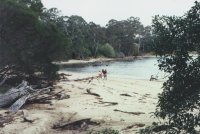 Naval historian Lew Lind wrote of Japanese submarines crews getting fresh water from wells on secluded beaches near Merimbula and Eden. Locals often heard the submarines recharging their batteries at night. Some believe they even refuelled at the wharf in Merimbula. Naval historian Lew Lind wrote of Japanese submarines crews getting fresh water from wells on secluded beaches near Merimbula and Eden. Locals often heard the submarines recharging their batteries at night. Some believe they even refuelled at the wharf in Merimbula.

If you have any items to share, or would like to be contacted when this page is updated, please send an email to the hmasmildura@hotmail.com 
|